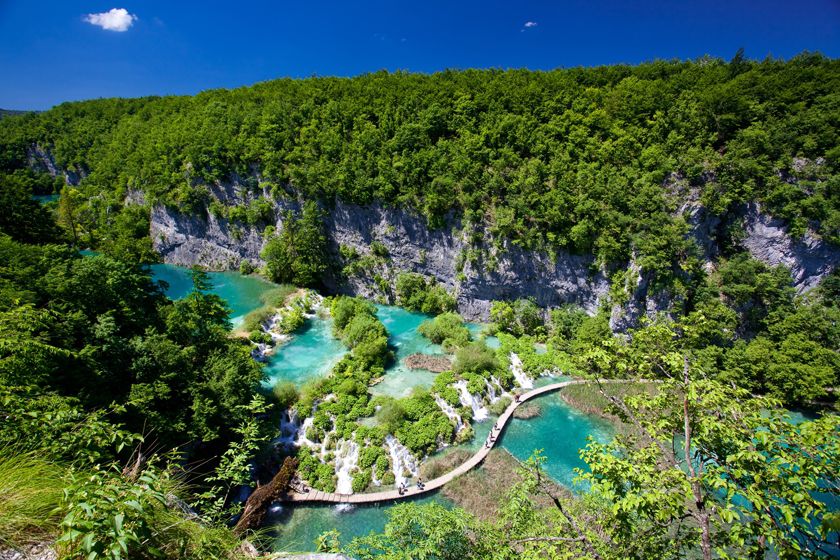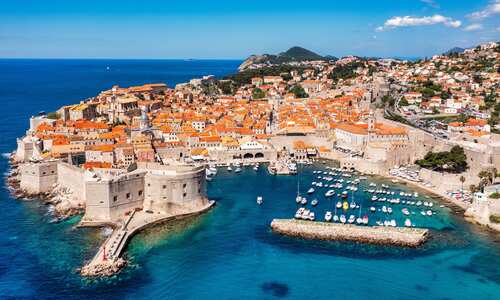Article content
26 February 2016 by Angela Perro
Read our introduction to Croatia, a spectacular country full of surprises that shows people what, 'the Mediterranean once was'.
With entry to the EU in 2013, Croatia achieved a spectacular turnaround from the War of Independence that devastated the country in the early 1990s and the subsequent break up of Yugoslavia broke the country politically and economically. Over a decade though Croatia has repositioned itself and built a new identity around its natural and cultural heritage, marketing itself as 'the Mediterranean as it once was.'
|
AT A GLANCE
|
With an improving infrastructure, extended road network and boom in quality accommodation, Croatia has never been easier to visit. An emerging holiday destination for some years, it's now popular with people keen on the outdoors, who come for adventure and activities such as hiking, sailing, scuba diving, mountain biking and rock climbing.
Although the Adriatic coast is rugged and devoid of the great swathes of sand found elsewhere in the Mediterranean, it is breathtakingly beautiful, indented with coves and inlets, backed by pine forests and overlooked by muscular mountains, making it visually stunning.
Then there's a wealth of history and culture to uncover in cities such as Zagreb, Dubrovnik, Split and Zadar. Visitors over the years have included the Romans, Byzantines, Venetians and Austro-Hungarians, all of who left their mark; old quarters in Dubrovnik and Split, cathedrals in Trogir and Sibenik and the basilica of Porec are all UNESCO world heritage sites.
When to go
The best months to explore Croatia are the shoulder season months of May-June and September-October, when you can look forward to warm weather, plenty of sun and all of the tourist facilities to be functioning, but without the crowds that can affect some areas during the high season summer months, when the coastal resorts in particular can become busy and both temperatures and hotel rates soar. The shoulder season months are also ideal for outdoor activities including hiking, mountain biking, rafting and sea-kayaking.
Getting there and around
There are now year-round flights between London and Zagreb (2hrs 15 min), and London and Dubrovnik (2hrs 40min), along with regular flights from Manchester to both Dubrovnik and Split. Airlines operating these routes include British Airways, Croatia Airlines and EasyJet. There's also a small network of internal flight options, with Croatia Airlines operating services from Zagreb to Dubrovnik, Pula, Split and Zadar.
Alternatively, take to the roads and tour the country under your own steam. Driving is relatively easy and Croatia boasts some of the newest motorways in Europe. Parking in towns can be difficult though. Lots of people also use the network of ferries and catamarans that connect the coast and the archipelago of islands slung carelessly along its length; there are 48 inhabited islands, many of which are readily accessible.
Where to go
|
Click on the Croatia map to enlarge it |
Essential Experiences |
Croatia has it all, so where you go will depend on what you're looking for. If you've just a week away stick to a single region and explore in depth; if you're travelling for longer then consider combining two or more regions to get a better appreciation of the diverse landscape and contrasting regions.
Istria

Istria is essentially a peninsula in the north-west of Croatia. The region has close ties to Italy and there are Venetian influenced houses throughout the attractive fishing villages here. Main centres include Pula, famed for its Roman amphitheatre, Rovinj, considered one of the country's best coastal resorts, and Porec, site of the stunning 6th-century Euphrasius Basilica. Inland from the seaside resorts are vineyards and hill towns known for their regional delicacies, including truffles.
Kvarner

The Kvarner Gulf, backed by bare mountains is a tranquil, attractive region. The port city of Rijeka is the hub of the Gulf although the nearby resort of Opatija is more popular, as is the stretch of coast from here to Lovran. Lots of people travel to the outlying islands, with Krk connected by bridge and the others easily reached by ferry; Rab and Pag are the most often visited. Away from the coast, head inland to the emerald-green lakes and crashing cascades of Plitvice National Park, which can be taken in either as a day trip from Rijeka, Zagreb or Zadar.
Dalmatia

In the north of the region, Zadar has an attractive old town and numerous Romanesque churches. Nearby the Kornati National Park is an archipelago of rocky islets ideally explored by sailing boat. The elongated island of Pag is well known for its regional lamb dish and local sheep's cheese. Look to work up an appetite by taking to the Velebit Mountains on the mainland first.
The centre of Dalmatia is dominated by Split; the main centre for sailing holidays, Split is also the gateway to the islands of Brac, Hvar and Vis. The bohemian chic of Hvar Town and the laidback Bol on Brac are the city highlights, whilst the renowned beaches of Zlatni Rat, on Brac, are amongst the best in all of Croatia. On the mainland, the Makarska Riviera is backed by mountains that are good for walking and cycling, whilst Omis is the put-in point for white water rafting on the River Cetina.

The southern section of Dalmatia is all about Dubrovnik. Croatia's best known and most expensive destination, Dubrovnik has an attractive old town and a wealth of contemporary, luxury hotels. South of here is the tranquil coastal resort of Cavtat. Dubrovnik is also a great base for people wanting to continue south and venture into neighbouring Montenegro, an ideal extension or detour if travelling through the south of Croatia. Further along the coast is Orebic, which is good for beaches, swimming and wind surfing, or hop the ferry to Korcula, which boats a lovely medieval stone-walled town. Other islands off the South Dalmatian coast include the heavily forested Mljet, whose beauty is encapsulated by the small isle of St Mary, itself at the centre of a lake, crowned by a picturesque monastery and church.
- Croatia's must-see destinations in a 10-day tour
- Discover Dubrovnik and the Dalmatian Coast
- Tour Dalmatia and stay on Hvar
- Twin centre break in Brac and Makarska
Where to stay
There are plenty of places to stay, from villas and homestays to luxury hotels. Many of the coastal hotels have good sea views and facilities, whilst renovated properties in Dubrovnik and on upmarket islands such as Hvar hold their own in terms of contemporary design and personalised service.
Top-rated hotels in Dubrovnik include:
- The Puric Palace - boutique hotel in an opulent 17th century noble house
- Hotel Excelsior - stunning views and superlative service at, 'one of the finest hotels in the Mediterranean'
Outside of the capital consider:
- Hotel Orphee - great value hotel on the Dubrovnik Riviera
- Hotel Villa Marija - family-run four-star hotel close to Split
Ready to go?
These additional itinerary ideas make it easy:







